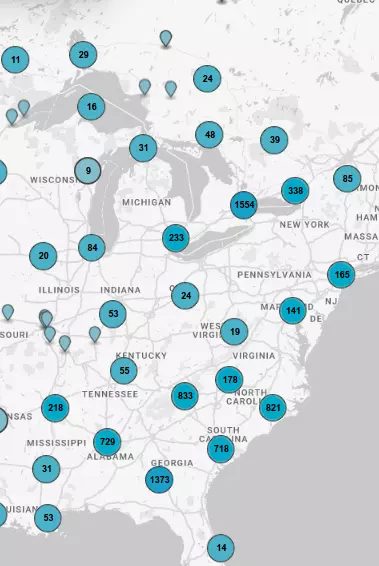Aviation Tragedy
In the evening hours of December 6, 1953 four F-84D jet aircraft of 128th Fighter Bomber Squadron of the Georgia Air National Guard crashed near this site. They were returning from a...
- lat34
Elisha Winn House
This house was built by Elisha Winn around 1812. In 1818, the Georgia General Assembly created Gwinnett County from Cherokee and Creek cessions and part of Jackson County. The first...
- lat34
Lawrenceville Female Seminary
The first building erected on this property was completed July 31, 1838 to house the Lawrenceville Female Seminary. The Reverend John S. Wilson was elected first president of the Board of...
- lat34
Fort Daniel
Fort Daniel was completed in 1813 to protect the frontier from Indians aroused by the British during the War of 1812. Presumably named for General Allen Daniel, the fort was garrisoned by the 25th...
- lat34
Gwinnett County
Created in 1818 from Cherokee and Creek cessions, Gwinnett is an original county. Courts, elections, and sheriff sales were held, first, in the home of Elisha Winn, 1 mile east of the Appalachee...
- lat34
Garrard's Cavalry Raid
On July 20, 1864, Union forces under Maj. Gen. W.T. Sherman, USA, were closing in on Atlanta. Hq. 2nd Cavalry Division. Brig. Gen. Kenner Garrard, was in Decatur, 6 miles E of Atlanta....
- lat34
Peachtree Road
At Fort Daniel on Hog Mountain, about 12 miles NE, began the original Peachtree Road to the village of Standing Peachtree on the Chattahoochee River. This old road was opened to haul military...
- lat34
Button Gwinnett
Button Gwinnett, for whom this county was named, was born in Gloucestershire, England, in 1735, the son of a Church of England minister. He worked in the store of his father-in-law in Dexter for...
- lat34
White Plains Baptist Church
White Plains Baptist Church was organized in 1806, with all four sanctuaries located here. The current sanctuary was constructed in 1887. Welcoming its first African-American member in 1812, both...
- lat34
Blue Star Memorial
A tribute to the Armed Forces that have defended the United States of America SPONSORED BY Greensboro Garden Club IN COOPERATION WITH Georgia Department of Transportation and City...
- lat34
Great Buffalo Lick
This site is described in the Treaty signed by the Creek and Cherokee Indians at Augusta, Georgia, in 1773. Here began the survey of the ceded lands. WPA 1936 Plaque courtesy Lat34North.com....
- lat34
William C. Dawson 1798-1856
Statesman - soldier - jurist- Freemason A native of Greene County, then on Georgia´s Indian frontier, he was educated in the law and admitted to the bar in 1818. The remainder of his...
- lat34
Sheriff L.L. Wyatt [side 2]
(Continued from other side) moonshiners resisted arrest, Wyatt regularly shot it out with them. He killed over a half dozen men, all of whom shot at him first. The most famous gunfight of...
- lat34
Sheriff L.L. Wyatt [side 1]
This 1895 jail is named for the legendary Sheriff, Loy Lee Wyatt, who enforced the laws in Greene County for fifty-two years until his death in 1977. Sheriff L.L. Wyatt was born on January...
- lat34
First Commissioner of Agriculture
In 1874, the Georgia Department of Agriculture was established by Act of the Legislature with Thomas P. Janes serving as its first Commissioner, 1874-79. Commissioner Janes, born 1823 in...
- lat34
Bishop George Foster Pierce (1811-1884)
Born February 3 in 1811 near Greensboro, George Foster Pierce was converted while at the University in Athens; in 1830 he followed his father, Dr. Lovick Pierce, into the Methodist ministry. He...
- lat34
New Hope Baptist Church
New Hope Baptist Church was constituted on January 15, 1800. Thirteen years after Greene County was created, by Rev. Joseph Baker, Rev. Thomas Mercer and others. These eleven charter members...
- lat34
Bethesda Baptist Church
When Bethesda Baptist Church was organized in 1785, it was known as Whatley´s Mill Church, and was in Wilkes County before it was added to Greene in 1802. When the present building was erected...
- lat34
Stagecoach Road
Near here ran the old Stagecoach Road from Augusta, Petersburg, Washington and Greensboro to Park´s Mill, where a toll bridge crossed the Oconee. After crossing the river the highway diverged ~...
- lat34
Fort Mathews
FORT MATHEWS About two miles South, in the fork of the Appalachee and Oconee rivers, stood Fort Mathews, built in 1793. From this fort, Thomas Houghton observed the activities of General...
- lat34
